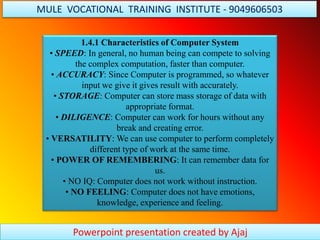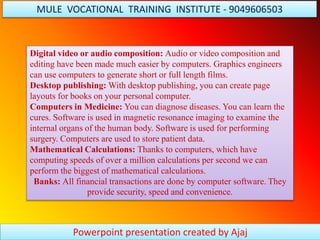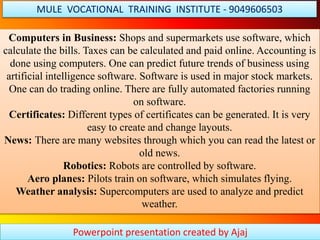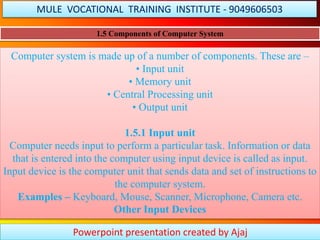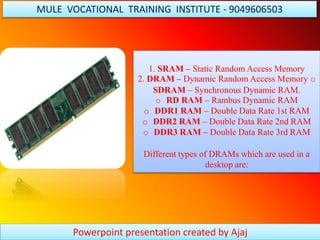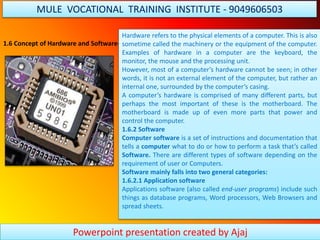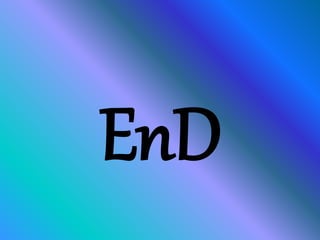The document provides an introduction to computers including:
1. The full form of computer is defined as commonly operated machine particularly used for technology education and research.
2. Computers are electronic devices that receive input, process data, and provide output. They are classified based on size, data handling abilities, and functionality.
3. The basic components of a computer system are described as the input, output, memory, and central processing unit.

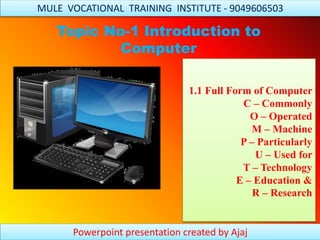
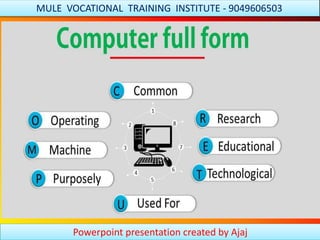



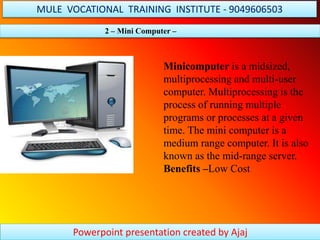
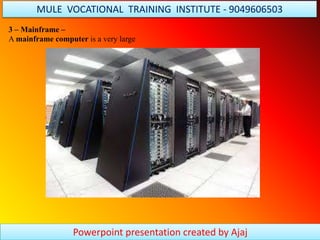

![First generation: 1946-1959 [Vacuum tube based]: First-generation computers
used vacuum tubes and values as their basic electronic component. They were
extremely large in size and electricity consuming. Some of the first-generation
computers are: ENIAC (electronic numerical integrator and calculator) – it was
built in 1946 at the university of PENNSYLVANIA, U S A by JOHN ECKERT and JOHN
MAUCHLY.
Second generation: 1959-1965 [Transistor based]: In the generation of
computers, transistors were used in place of vacuum tubes. Transistors are more
compact than vacuum tubes as they are made up of semiconductors. They are
also more durable than vacuum tubes. Its size was used smaller as compared to
the first-generation computers and it was used mostly for scientific purpose. IBM
1401- IT was used for was business application. CDC 3600- IT was used for
scientific purpose.
Third generation: 1965-1971 [Integrated Circuit based]: PDP – 8 -Developed by
DEC in 1965. IBM- 360- Developed by IBM in 1964. In the third generation of
computers integrated circuits (ICs) began to be used. These ICs were called chips.
These ICs are more compact than a transistor. Single ICs has many transistors,
registers and capacitors. So the computer built of such components became
smaller.
Powerpoint presentation created by Ajaj
MULE VOCATIONAL TRAINING INSTITUTE - 9049606503](https://image.slidesharecdn.com/pptcomputerbyajaj-211205044900/85/Ppt-computer-by-ajaj-10-320.jpg)
![Forth generation: 1971-1980 [VLSI microprocessor based]: The
computers of fourth generation used Very Large Scale Integrated
(VLSI) circuits. VLSI circuits having about 5000 transistors and other
circuit elements and their associated circuits on a single chip made it
possible to have microcomputers of fourth generation. Fourth
generation computers became more powerful, compact, reliable, and
affordable. In this generation time sharing, real time, networks,
distributed operating system were used. All the high-level languages
like C, C++, DBASE etc., were used in this generation. Some CRAY-
X-MP (Super Computer) CRAY-1(Super Computer) PDP 11 STAR
1000 of the computers developed during this period are DEC 10.
Fifth generation: 1980-onwards. [ULSI microprocessor based]: In
the fifth generation, the VLSI technology became ULSI (Ultra Large
Scale Integration) technology. All the high-level languages like C and
C++, Java, .Net etc., are used in this generation.
Powerpoint presentation created by Ajaj
MULE VOCATIONAL TRAINING INSTITUTE - 9049606503](https://image.slidesharecdn.com/pptcomputerbyajaj-211205044900/85/Ppt-computer-by-ajaj-11-320.jpg)
